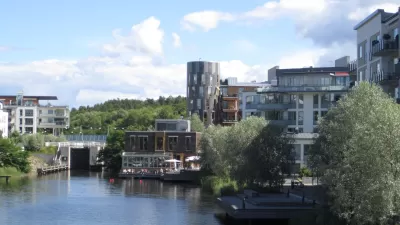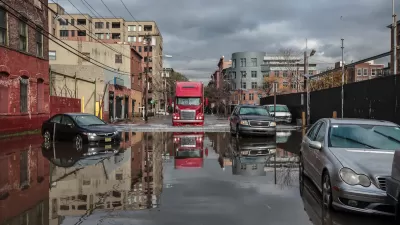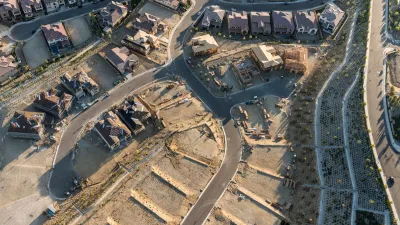An investigation of how resilience relates to sustainability, and how an understanding of that relationship informs more effective development investments.

This is an update and expansion of a paper that I wrote in 2016, "A New Metric for Community Resilience," which presented an evidence-based index to estimate the resilience of a community. The purpose of this update is to study the validity of the index as an estimate of a community’s resilience through an analysis of its relationship with sustainability.
The proposed evidence-based index is in contrast to other measurements of resilience that focus on capacity, defined in terms of such systemic characteristics as diversity, connectedness and more (see, for example Webb, 2007; Holling et al., 2002; Walker & Salt, 2006). Theoretically, as these characteristics are developed and improved, a city’s resilience will also improve.[1] An evidence-based estimate of resilience would instead focus on a community’s apparent ability to withstand and adjust to myriad and constant disturbances.
This study draws from the published discussion of the relationship between resilience and sustainability. One of the more comprehensive reviews of this discussion identified three causal "perspectives": 1) resilience makes a system more sustainable; 2) sustainability contributes to a system’s resilience; and 3) sustainability and resilience are separate and may or may not contribute to one another in terms of their impact on systems. Which or whether any of these three perspectives is the "correct" one is a question that remains unsettled.
By characterizing resilience and sustainability as states rather than processes, it becomes possible to inform these perspectives. As presented in my 2016 paper, a possible formula for an evidence-based estimate of resilience (i.e., the resilient state of a community) consists of the following multi-dimensional components:
- Unemployment (UNEMP) – variability, magnitude, trend, and recovery
Violent crime per 1000 population (VCRIME) – variability and trend
Population change (POP) – trend
These dimensions are defined as follows:
- Variability (V) – standard deviation over the period
- Magnitude (M) – average value over the period
- Trend (TR) – linear extrapolation of values over the period and a calculation of the change between beginning (BV) and ending values (EV)
- Recovery (RE) – difference between maximum value (MVt) over the period and some subsequent value (SVt+i) later in the period divided by MVt, i.e., where t = the year of the maximum value and i = some number of years after t.[2]
The calculations for each of the components are:
- UNEMP: ((V + M) * (1 + TR)) * (1 – RE)
- VCRIME: ((V + M) * (1 + TR))
- POP: (BV/EV)*10
Resilience, then, is calculated as RIe = (1/(UNEMP + VCRIME + POP))*100, where the subscript e indicates the evidentiary nature of the index. A high level of resilience is reflected in a high RIe value.[3]
To evaluate its relevance to the theoretical relationship between resilience and sustainability,[4] the 2019 U.S. Cities Sustainable Development Report (Lynch et al. 2019) calculated the 2017 Resilience Index for 60 U.S. cities. This extensive report characterizes and evaluates the sustainable development of 105 U.S. metropolitan areas in terms of 57 indicators that correspond to 17 goals, related to such characteristics as education, sanitation, infrastructure, etc., in the form of a sustainable development index (SDI).
The design of the study reported here is based on the following assumptions: a) resilience is a consequence of policies of governance, b) the resilience of central cities reflects policies of governance, c) sustainable development is a possible consequence of policies of resilience, d) central cities have an influential impact on their surrounding suburbs (for an excellent discussion of that assumption, see Herrschel, 2010), and e) lagging the RIe will incorporate impact into the analysis.
The hypothesis is that the resilience of central cities as measured by the RIe has a significant relationship with the sustainable development of their metropolitan areas as measured by the SDI.
Statistical analysis to test the hypothesis revealed a correlation of r=.45 between the RIe (2017) and SDI (2019) scores, which is statistically significant at p=.00031. T-testing revealed that the mean RIe of the 30 metropolitan areas with the highest and lowest SDI differed significantly (4.26 and 3.62, respectively, p=.0024). Finally, multiple regression analysis to predict SDI, while revealing much yet to be explained, showed RIe to be the most significant independent variable among the three included in the model, as shown below:
Predictor Model for the Sustainable Development Index
|
Independent variable |
Coefficient |
t-statistic |
P-value |
|
Resilience index (RIe) Percentage* SMSA** |
5.22 -15.48 .946 |
4.30 -2.13 2.74 |
.000069 .037504 .008113 |
|
Intercept |
31.23 |
6.12 |
.0000001 |
|
R2adjusted = .31 F = 9.78 n = 60 |
|||
|
* Percentage = Central city population as percent of SMSA population **SMSA = Metropolitan area population |
To the extent that the SDI and RIe are accepted as valid representations of resilience and sustainable development, these results support the hypothesis that the resilience of central cities and the sustainable development of their metropolitan areas are related. The results further suggest that cities can contribute to the sustainable development of their metropolitan areas by developing an approach to governance that builds their resilience. Such contribution may be a consequence of the increasing level of regional (metropolitan) connectivity that was noted by Herrschel (2010)—i.e., informal and formal linkages between individuals and governments driven by a vision of shared destiny.[5]
Simply put, evidence suggests that central cities have an opportunity through policies of resilience to help steer entire metropolitan areas toward greater sustainability. To maximize this impact, cities need to understand that resilience may not necessarily contribute to sustainability and use that understanding to frame their policies appropriately.
Edward J. Jepson, Jr., Ph.D., AICP teaches online planning courses for several universities in the United States. If you would like a copy of the methodology to calculate the RIe for the 60 cities or other information about this paper, he can be contacted at ejjplanning@gmail.com.
Sources
Herrschel, T. 2010. Cities, Suburbs and Metropolitan Areas – Governing the Regionalised City. In Suburbanization in global society, M. Clapson and R. Hutchison, eds. London: Emerald. Available at https://pdfs.semanticscholar.org/9e9e/2cd7033cbbea517fa4a31e648360fd7c2c85.pdf
Lynch, A., LoPresti, A., and Fox, C. 2019. The 2019 US Cities Sustainable Development Report. New York: Sustainable Development Solutions Network (SDSN). Available at https://www.sustainabledevelopment.report/reports/2019-us-cities-sustainable-development-report/
Metro Mayors Caucus. Available at https://medium.com/@metrorev/what-makes-cities-and-suburbs-set-aside-old-conflicts-and-collaborate-to-compete-7bc7d7cfd082
[1] A proposal of measurement that builds on the concept of capacity is the "City Resilience Index" (CRI) that can be found at https://www.100resilientcities.org/tools/city-resilience-index/. It consists of 52 indicators organized around twelve goals, which in turn are organized around the four dimensions of health and well-being, economy and society, infrastructure and environment, and leadership and strategy.
[2] In the RIe formula used for this analysis, SV is calculated two years after the MV occurred.
[3] Because the calculated value of POP is much smaller than the values of UNEMP and VCRIME, it has been adjusted with a multiplier of 10. This results in relative equalization of the levels of impact of the three components on RIe.
[4] My 2016 paper includes a brief discussion, including references, of the theoretical relationship between resilience and sustainability.
[5] An excellent example of formal connectivity is Denver’s Metro Mayors Caucus, which provides a forum for discussion and decision making among the mayors of the region based on consensus rather than majority vote.

Alabama: Trump Terminates Settlements for Black Communities Harmed By Raw Sewage
Trump deemed the landmark civil rights agreement “illegal DEI and environmental justice policy.”

Study: Maui’s Plan to Convert Vacation Rentals to Long-Term Housing Could Cause Nearly $1 Billion Economic Loss
The plan would reduce visitor accommodation by 25% resulting in 1,900 jobs lost.

Planetizen Federal Action Tracker
A weekly monitor of how Trump’s orders and actions are impacting planners and planning in America.

Grand Rapids Mayor Proposes Garage Conversion Plan
The mayor says allowing homeowners to convert garages to dwelling units could alleviate the city’s housing shortage.

Baltimore Ordered to Improve Sidewalk Accessibility
The city is one of many to face lawsuits for failing to comply with the Americans with Disabilities Act.

This Toronto Suburb Has More Bus Riders Than Columbus, Ohio
Brampton, Ontario used gradual improvements in service to prove that if you build it, they will ride.
Urban Design for Planners 1: Software Tools
This six-course series explores essential urban design concepts using open source software and equips planners with the tools they need to participate fully in the urban design process.
Planning for Universal Design
Learn the tools for implementing Universal Design in planning regulations.
Smith Gee Studio
Alamo Area Metropolitan Planning Organization
City of Santa Clarita
Institute for Housing and Urban Development Studies (IHS)
City of Grandview
Harvard GSD Executive Education
Toledo-Lucas County Plan Commissions
Salt Lake City
NYU Wagner Graduate School of Public Service





























